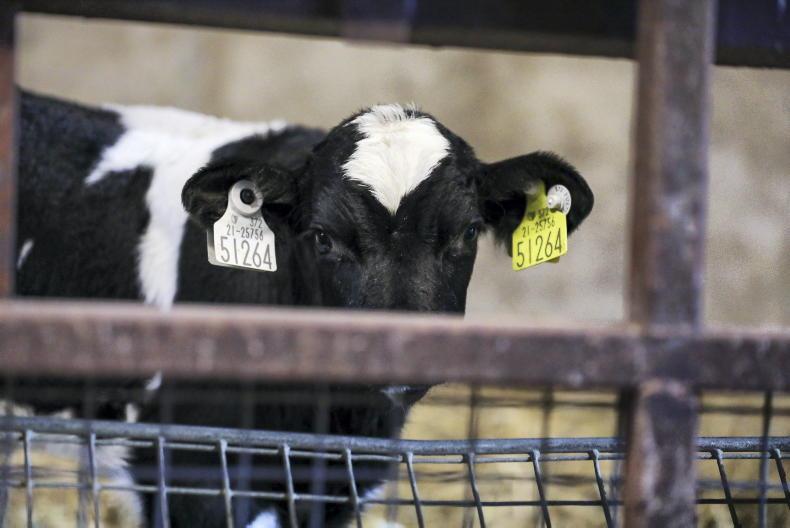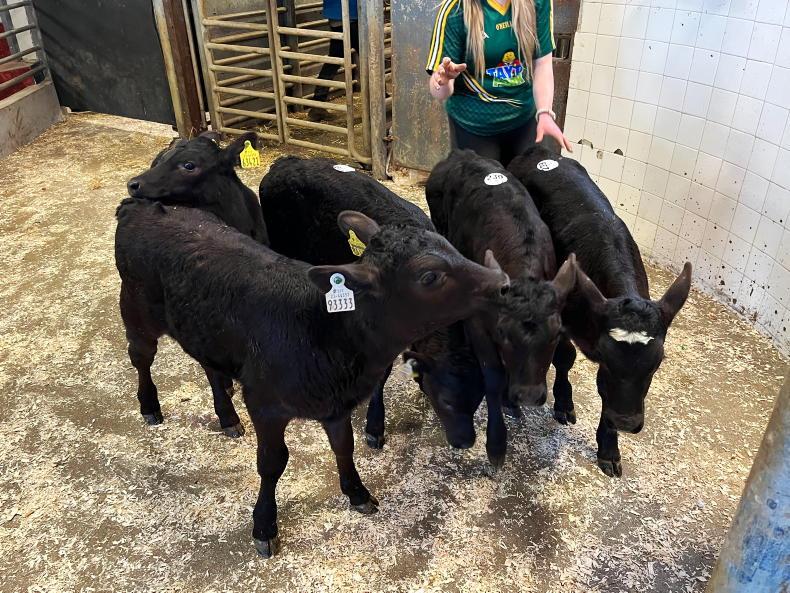The performance of live exports was a bright feature of 2023, with the number of cattle exported increasing by 36,332 head, or 15%, on levels recorded in 2022.
There is also a positive short-term outlook for 2024, with Bord Bia livestock manager with responsibility for live exports Seamus McMenamin, forecasting steady demand for at least the first half of 2024.
“Live exports have featured regularly in the media in recent months, with an increasing focus on transport regulations. We are likely to see pressure on the trade in the medium to longer term, but all short-term trade signals point to a positive outlook,” he said.

. \ Odhran Ducie
Greatest activity
The highest level of activity was recorded in the first half of 2023 underpinned by calf exports, but volumes moving in the latter half of the year have also trended above normal levels.
This was helped by tighter cattle supplies across Europe and bluetongue-related movement restrictions.
Table 1 details the main countries where calves were exported to in the last three years. As can be quickly seen, the Netherlands and Spain continue to dominate the trade, accounting for over 50% of cattle exports.
Table 2 details total exports by animal type for the last three years. Calf exports are running 21%, or in excess of 36,000 head, higher. Exports of weanlings have also performed strongly, rising by 2% on 2022.
In contrast, exports classified as store cattle are running 11% lower. This is due in part to lower number of older bulls being exported to Libya.
The category ‘finished cattle’ refers to animals aged in excess of 24 months and also includes cows.
The main change here has been higher exports of cattle to Northern Ireland.
Seamus highlights tighter cattle supplies in Northern Ireland in 2023 and a wider differential in beef price as being two significant factors helping the trade.
The trade for top-quality beef cows continues to stand out as a category that is particularly benefitting from a keen appetite.

This group of five six-week-old bull calves, weighing 71kg, sold for €180 (€2.54/kg).
Main destinations
As mentioned already, the Netherlands and Spain were the main destinations for Irish cattle exported live in recent years. Exports to the Netherlands increased by 11%, with exports of calves accounting for over 99% of trade volumes in 2023. Demand from Dutch buyers has been underpinned by lower domestic supplies of calves and tighter availability of calves from Germany and other Eastern European countries. Calf exports account for almost 79% of cattle exported live to Spain. The balance has typically been made up of dairy-cross calves aged over three months of age and dairy-cross yearlings and stores. There has been an increase of over 7,000 head in the number of calves exported to Italy. Calf exports here are mainly Friesian bulls and small numbers of beef-cross calves.
There has been some diversification into Eastern European markets and these markets have shown growth potential. The Netherlands market remains a potentially high-risk market, taking 51% of calves, given the political pressure on calf exports along with discussions on the IBR status of animals exported.
Other risks to the calf export trade include changing EU legislation, NGOs campaigning against live exports, health status of calves, including IBR and ferry companies ability to manage logistics. There could possibly be more calves in the market in Ireland in 2024 given the phasing out of calf slaughtering.
Italian market
Italy has become an important market for calves from the dairy herd in recent years. Dutch veal producers have diversified production outside of the Netherlands and in cases have moved production closer to one of its end markets for veal. Exports to Northern Ireland have already been discussed in detail, while Libya has been replaced by Poland as the fifth most important destination on a numerical basis.
The increase in exports to Poland has, like Italy, also been driven by beef-sired calves from the dairy herd and Friesian bulls. Higher exports to Hungary, Romania, Bulgaria and Slovakia was underpinned by keen demand from the Turkish market, with all four countries carrying out significant business with Turkey in 2023. Some consignments also included beef breeding animals.
Exports to Libya reduced in 2023, but this outlet has been compensated for by the 6,840 head of cattle exported live to Israel in recent months.
Seamus adds that there is keen interest in Irish cattle from a number of north African destinations, with trade largely dependent on economics.
Reports indicate that exporters are planning shipments to those markets in early 2024.
The performance of live exports was a bright feature of 2023, with the number of cattle exported increasing by 36,332 head, or 15%, on levels recorded in 2022.
There is also a positive short-term outlook for 2024, with Bord Bia livestock manager with responsibility for live exports Seamus McMenamin, forecasting steady demand for at least the first half of 2024.
“Live exports have featured regularly in the media in recent months, with an increasing focus on transport regulations. We are likely to see pressure on the trade in the medium to longer term, but all short-term trade signals point to a positive outlook,” he said.

. \ Odhran Ducie
Greatest activity
The highest level of activity was recorded in the first half of 2023 underpinned by calf exports, but volumes moving in the latter half of the year have also trended above normal levels.
This was helped by tighter cattle supplies across Europe and bluetongue-related movement restrictions.
Table 1 details the main countries where calves were exported to in the last three years. As can be quickly seen, the Netherlands and Spain continue to dominate the trade, accounting for over 50% of cattle exports.
Table 2 details total exports by animal type for the last three years. Calf exports are running 21%, or in excess of 36,000 head, higher. Exports of weanlings have also performed strongly, rising by 2% on 2022.
In contrast, exports classified as store cattle are running 11% lower. This is due in part to lower number of older bulls being exported to Libya.
The category ‘finished cattle’ refers to animals aged in excess of 24 months and also includes cows.
The main change here has been higher exports of cattle to Northern Ireland.
Seamus highlights tighter cattle supplies in Northern Ireland in 2023 and a wider differential in beef price as being two significant factors helping the trade.
The trade for top-quality beef cows continues to stand out as a category that is particularly benefitting from a keen appetite.

This group of five six-week-old bull calves, weighing 71kg, sold for €180 (€2.54/kg).
Main destinations
As mentioned already, the Netherlands and Spain were the main destinations for Irish cattle exported live in recent years. Exports to the Netherlands increased by 11%, with exports of calves accounting for over 99% of trade volumes in 2023. Demand from Dutch buyers has been underpinned by lower domestic supplies of calves and tighter availability of calves from Germany and other Eastern European countries. Calf exports account for almost 79% of cattle exported live to Spain. The balance has typically been made up of dairy-cross calves aged over three months of age and dairy-cross yearlings and stores. There has been an increase of over 7,000 head in the number of calves exported to Italy. Calf exports here are mainly Friesian bulls and small numbers of beef-cross calves.
There has been some diversification into Eastern European markets and these markets have shown growth potential. The Netherlands market remains a potentially high-risk market, taking 51% of calves, given the political pressure on calf exports along with discussions on the IBR status of animals exported.
Other risks to the calf export trade include changing EU legislation, NGOs campaigning against live exports, health status of calves, including IBR and ferry companies ability to manage logistics. There could possibly be more calves in the market in Ireland in 2024 given the phasing out of calf slaughtering.
Italian market
Italy has become an important market for calves from the dairy herd in recent years. Dutch veal producers have diversified production outside of the Netherlands and in cases have moved production closer to one of its end markets for veal. Exports to Northern Ireland have already been discussed in detail, while Libya has been replaced by Poland as the fifth most important destination on a numerical basis.
The increase in exports to Poland has, like Italy, also been driven by beef-sired calves from the dairy herd and Friesian bulls. Higher exports to Hungary, Romania, Bulgaria and Slovakia was underpinned by keen demand from the Turkish market, with all four countries carrying out significant business with Turkey in 2023. Some consignments also included beef breeding animals.
Exports to Libya reduced in 2023, but this outlet has been compensated for by the 6,840 head of cattle exported live to Israel in recent months.
Seamus adds that there is keen interest in Irish cattle from a number of north African destinations, with trade largely dependent on economics.
Reports indicate that exporters are planning shipments to those markets in early 2024.








 This is a subscriber-only article
This is a subscriber-only article










SHARING OPTIONS: